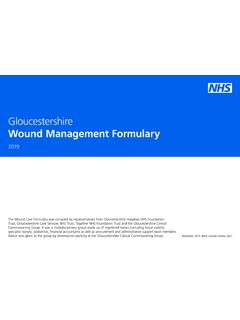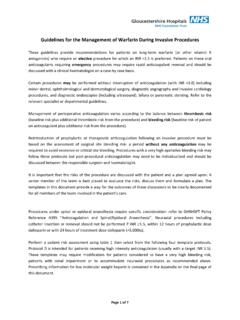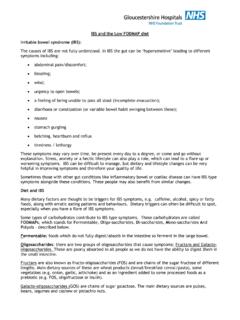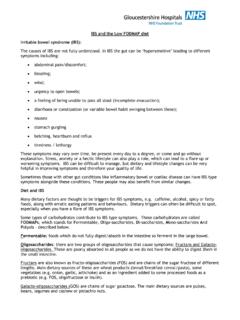Transcription of Statin Prescribing - Gloucestershire Hospitals NHS ...
1 Author: Dr Kokswee Gan Approved by GHNHSFT Drug & Therapeutics Committee: February 2018 Review date: February 2021 Page 1 of 7 Treatment Guideline Statin Prescribing Objective These guidelines represent the views of the Gloucestershire Hospitals NHS Foundation Trust, which were arrived at after consideration of the available evidence and the development of consensus. They aim to ensure equity and best practice within the context of resources currently available to the NHS locally. This is a lipid lowering drug strategy which should only be used within an overall lifestyle and clinical management strategy.
2 Health professionals are asked to take these guidelines into account when exercising their clinical judgement and are encouraged to discuss with colleagues those cases where the assessment of likely benefit from a particular intervention is equivocal. The guidelines do not override the responsibility of health professionals to make appropriate decisions in the circumstances of the individual patient in consultation with the patient and/or carer. Population to be treated1, 2 Treatment with a Statin is recommended in the following people with: Total CVD risk 10% over 10 years (using QRISK 3), including people with type 2 diabetes Established CVD Type 1 diabetes who.
3 - are older than 40 years, or - have had diabetes for more than 10 years, or - have established nephropathy, or - have other cardiovascular disease risk factors CKD stages 3 5 Individuals with a high lifetime CVD risk estimated from heart age and other JBS3 calculator metrics, in whom lifestyle changes alone are considered insufficient by the physician and person concerned Familial dyslipidaemia: familial hypercholesterolaemia (FH) and other inherited disorders of lipid metabolism Standard CVD risk scores will underestimate risk in people with: HIV treatment; serious mental health problems; antipsychotics, corticosteroids and immunosuppressant drugs; autoimmune and systemic inflammatory disorders; severe obesity (BMI>40).
4 Please also refer to the supporting notes regarding elderly patients on page 6 of this document. Page 2 of 7 Indication for Statin treatment (see population to be treated on page 1) Investigate and treat secondary causes of hyperlipidaemia before starting Statin treatment: excess alcohol, uncontrolled diabetes, hypothyroidism, nephrotic syndrome, liver disease and paraproteinaemia. Atorvastatin 20mg daily Re-check lipids at 3 months Target achieved? (page 3) Continue treatment Atorvastatin 40mg to 80mg daily Re-check lipids at 3 months Target achieved? (page 3) Atorvastatin 40mg/80mg daily plus Ezetimibe 10mg daily Re-check lipids at 3 months Target achieved?
5 (page 3) Yes No Continue treatment Continue treatment If intolerant of Atorvastatin, consider: 1. Simvastatin, Pravastatin, Rosuvastatin, (Fluvastatin), Rosuvastatin 5mg non-daily dose (1-3 tablets weekly); - Initiate at lowest dose. - Assess efficacy required (see Grouping of statins : Table 1 on page 3) & risk of potential drug interactions (see page 5). - Use lowest acquisition cost. 2. Ezetimibe (see restrictions on page 4). Refer to Lipid Clinic CAUTIONS: (Please also refer to BNF for further Prescribing information) Initiate with a lower dose and avoid very high dose or high intensity statins if at increased risk of myotoxicity the elderly, severe renal impairment (eGFR<30), liver impairment, undertreated hypothyroidism, high alcohol intake, history of previous Statin or muscle toxicity, trauma/major surgery, and concomitant medications (see page 5 for interactions).
6 All statins are contraindicated in active liver disease, pregnancy (adequate contraception required during treatment) and breast-feeding. statins (except rosuvastatin) should be avoided in porphyria. Large quantities of grapefruit juice raise simvastatin and atorvastatin exposure. If pre-treatment total cholesterol > (LDL > ) & family history of premature CHD Yes No Yes No - Check compliance before changing Statin / titrating dose. - In HIV patients taking protease inhibitors, use pravastatin. Mixed hyperlipidaemia is common. Combination of Statin with fibrate may be required. Refer to Lipid Clinic.
7 - For monitoring of lipids, LFT s, CK, see supporting notes on page 4. - Patients with ACS may be initiated on intensive lipid lowering therapy atorvastatin 40mg/80mg daily. Author: Dr Kokswee Gan Approved by GHNHSFT Drug & Therapeutics Committee: February 2018 Review date: February 2021 Page 3 of 7 Grouping of statins Reduction in low-density lipoprotein cholesterol Dose (mg/day) 5 10 20 40 80 Fluvastatin - - 21% 27% 33% Pravastatin - 20% 24% 29% - Simvastatin - 27% 32% 37% *42% Atorvastatin - 37% 43% 49% 55% Rosuvastatin 38% 43% 48% 53% Low intensity Medium intensity high intensity Treatment targets JBS32 recommends the following new targets.
8 Thresholds for treatment with statins based on 10-year CVD risk will be informed by National Institute for Health and Care Excellence (NICE) guidelines. For all patients with established CVD statins should be prescribed with a lower is better approach to achieve values of at least < mmol/L for non-HDL-C (equivalent to < mmol/L for LDL-C). NICE Clinical Guidance CG1811 recommends: Discuss with people who are stable on a low- or middle- intensity Statin the likely benefits and potential risks of changing to a high - intensity Statin when they have a medication review and agree with the person whether a change is needed.
9 In all people who have been started on high - intensity Statin treatment (both primary and secondary prevention, including atorvastatin 20 mg for primary prevention) aim for a greater than 40% reduction in non-HDL cholesterol. European Atherosclerosis Society (EAS) recommends11: - Low to moderate risk: LDL-C <3 mmol/L - high -risk: LDL-C < mmol/L or a reduction of at least 50% if the baseline is between and mmol/L - Very high -risk: LDL-C < mmol/L or a reduction of at least 50% if the baseline is between and mmol/L (see EAS guidelines for risk categories) We recommend that if resources allow, the JBS3 targets should be achieved especially in secondary prevention (for those with established cardiovascular disease and/or diabetes).
10 *Advice from the MHRA: there is an increased risk of myopathy associated with high dose (80 mg) simvastatin. The 80 mg dose should be considered only in patients with severe hypercholesterolaemia and high risk of cardiovascular complications who have not achieved their treatment goals on lower doses, when the benefits are expected to outweigh the potential risks. Author: Dr Kokswee Gan Approved by GHNHSFT Drug & Therapeutics Committee: February 2018 Review date: February 2021 Page 4 of 7 Monitoring Lipids: Measure both total and HDL cholesterol for CVD risk assessment. Before starting Statin , take at least 1 non-fasting sample to measure a full lipid profile = total cholesterol, HDL-C, non-HDL-C and triglyceride concentrations.














